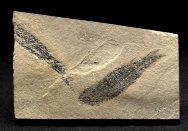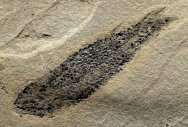Osteolepis panderi
Class Sarcopterygii, Infraclass Tetrapodomorpha, Superorder Osteolepidida, Order Osteolepiformes, Family Osteolepidae
Geological Time: Middle Devonain
Size: 75 mm
Fossil Site: Old Red Sandstone Beds, Caithness, Scotland
Osteolepiformes is also included in an unranked (but believed monophyletic) clade Rhipidistia made up of Tetrapoda and still extant lungfishes and Coelacanths. Traits that place Osteolepis within the lobe-finned fish are paired lobed fins and posterior nasal passages called choanae between the nasal cavity and the throat in tetrapods, including humans, that allow breathing when the mouth is closed. Osteolepis is also noted for think rhombic-shaped as seem in the fossil images here. These Devonian fish had many characteristics that would be largely retained when the first fish walked ashore. Images by permission from Fossil Mall (CC BY-NC 4.0) Also see: Sarcopterygii Fish Fossils Osteolepis macrolepidotus |




